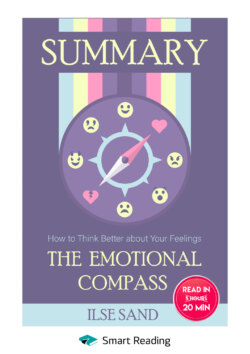Читать книгу Summary: The Emotional Compass. How to Think Better about Your Feelings. Ilse Sand - Smart Reading, Ольга Ганкова - Страница 3
Determine What You Feel
ОглавлениеAll feelings are divided into basic and mixed. Basic feelings are those that are experienced by all the people and even some of the more advanced animal species. Other emotions are either variations of basic feelings or a mix of them. Usually psychologists distinguish between four basic feelings:
▶happiness;
▶sadness;
▶fear/anxiety;
▶anger.
The better we understand what we feel, the easier it is to make decisions about how to react to this or that situation. If you are not sure about what you are feeling at any given moment, run a short analysis of the basic feelings:
▶Is there something I am angry about?
▶Is there something I am sad about?
▶Could I be scared?
▶Could I be feeling a slight tinge of happiness?
Very often we can’t determine what we feel until the feeling reaches a certain level of intensity. Using a scale of zero to 10, where zero is no feeling and 10 is the strongest level of feeling, it may be hard for us to detect what we feel if it is below five. But the earlier you discover what you feel, the more time it gives you to figure out what to do next. It is especially important to notice anger. Reaching your boiling point, you lose the ability to control yourself and be flexible in your thinking. One of the ways to recognize anger is to pay attention to your bodily sensations. You can illustrate your level of anger by using this scale below, listing emotions from the lowest intensity to the highest.
▶slight sensation of "I don’t like something";
▶irritation;
▶anger;
▶rage;
▶face getting red from rage;
▶face getting pale from rage.
Feeling intensity depends on how meaningful the relationship is. The more the person means to you, the angrier you are at him or her or, the happier you with him or her.
It’s also important to pay attention to the dominate thought. For example, if the dominating thought comes in tandem with a confusing feeling, for example "he treated me so unfairly", then, most probably, you are angry. Similarly, this occurs when you are judging other people and thoughts like "Where do they get off doing/thinking like that!!"
Another way of figuring out what you feel is to determine what you want. Every feeling has an impulse attached to it, a call for action. Ask yourself what your body feels now in a situation where something is bothering you. Imagine what kind of movement would have satisfied your body at this moment. For instance, if you feel restlessness in your legs, ask yourself what you think your legs would want to be doing right now. If you feel like runing, then you are probably anxious; if you feel like kicking something, then you are angry.
Remove the equals sign between yourself and your feelings. We have feelings, but we are not our feelings. Try to distance yourself from your emerging emotion and decide whether you want to succumb to it or not. Remember that you have this choice.
